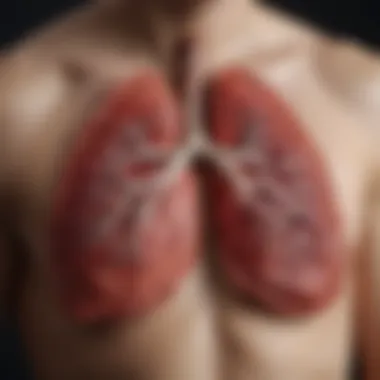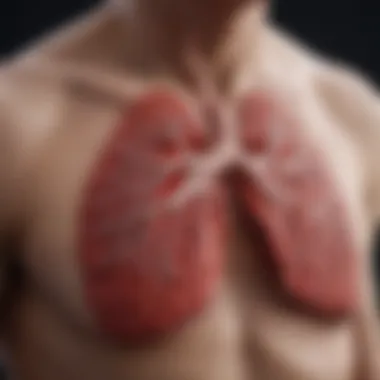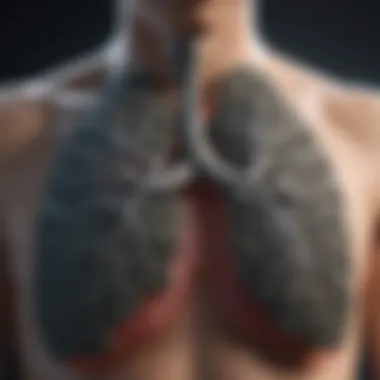Exploring the Role of Lungs in Chinese Medicine


Intro
In the realm of Chinese medicine, the lungs play a crucial role that extends far beyond mere respiratory functions. They are not just organs responsible for the exchange of oxygen; they are integral to both physical health and emotional well-being. Understanding the lungs' significance in this holistic medical paradigm offers insights that connect physiological processes with the intricate web of emotional states and energetic dynamics.
This exploration aims to uncover how traditional wisdom regarding lung health aligns with modern scientific understandings. By looking at these ancient concepts through a contemporary lens, we can gain deeper insights into the complex interplay between the lungs and various aspects of well-being.
Through examining the concept of Qi—the life force that flows through every being—and the environmental factors that influence lung health, we can appreciate the fullness of what lungs represent in traditional Chinese medicine. Furthermore, by discussing treatment modalities—ranging from herbal remedies to qigong practices—we aim to provide a comprehensive overview suitable for both novices and seasoned practitioners alike.
Preface to Chinese Medicine and Its Principles
Understanding the role of the lungs in Chinese medicine starts by diving into the foundational principles of the discipline itself. Traditional Chinese Medicine (TCM) is not merely a set of medical practices; it encompasses a worldview that sees health through a different lens. Its emphasis on balance and harmony echoes profoundly in its approach to various bodily systems, including the lungs.
Overview of Traditional Chinese Medicine
Traditional Chinese Medicine, with roots that stretch back thousands of years, is built upon complex theories that interlink the physical, emotional, and spiritual realms of existence. TCM approaches health by considering not just the symptoms but the whole person. This holistic view holds that the human body is a microcosm of the universe, reflecting the intricate interplay of natural forces.
- Holistic Framework: TCM prioritizes balance across bodily systems and interactions with external elements. It rejects the notion of isolating symptoms from their broader context.
- Preventative Care: Health in TCM is more about prevention than cure. Techniques are employed not just to remedy immediate ailments but to foster long-term wellness.
- Integration with Lifestyle: TCM incorporates aspects like diet, exercise, and emotional well-being into medical practice, creating a seamless blend of lifestyle management and health care.
The Concept of Qi and Its Importance
At the heart of TCM lies the concept of Qi (pronounced “chee”), the vital energy that flows through the body, connecting and sustaining physiological functions. Qi is considered the essence of life. Maintaining its proper flow is essential for health, and any disruption can lead to illness.
- Energy Flow: Qi travels through pathways known as meridians, enabling interaction between organs and systems. Blockages or imbalances in Qi flow can lead to various health disturbances.
- Dynamic Nature: Qi is dynamic, evolving with the environment and one’s internal state. Thus, understanding individual Qi helps practitioners tailor health strategies to each person’s unique circumstances.
- Interconnectedness: Recognizing that Qi is interconnected with emotional and spiritual states helps in holistic treatment approaches, as emotional turbulence can have direct impacts on physical health, particularly in the lungs.
Elements of Chinese Medicine: Yin, Yang, and Five Elements
Another core tenet of TCM involves the interrelated philosophies of Yin and Yang, as well as the Five Elements (Wood, Fire, Earth, Metal, Water). These constructs provide a framework for understanding bodily processes and imbalances.
- Yin and Yang: This duality represents the balance of opposing forces. Yin embodies coolness, darkness, and receptivity, while Yang exudes warmth, light, and activity. A healthy body maintains a fine balance between these two energies.
- Five Elements Theory: Each element corresponds to various organs and emotional states. For example, the Metal element relates to the lungs and grief. Understanding these connections aids practitioners in diagnosing and treating ailments.
- Wood: Growth and vitality, associated with the liver.
- Fire: Joy and activity, linked to the heart.
- Earth: Stability and nourishment, pertaining to the spleen.
- Metal: Grief and introspection, connected to the lungs.
- Water: Fear and adaptability, associated with the kidneys.
The principles of Traditional Chinese Medicine lay a robust foundation for understanding the lungs’ significance in health. By grasping these concepts, we can delve deeper into how the lungs function physiologically, emotionally, and energetically within this ancient system of medicine.
The Role of the Lungs in Chinese Medicine
In traditional Chinese medicine (TCM), the lungs are viewed as more than just respiratory organs; they hold a profound significance tied to the overall vitality and emotional landscape of an individual. The belief goes that the lungs act as a bridge between the external environment and the internal body. They regulate not only breath but also the flow of Qi, which is the fundamental energy sustaining all life. A deeper understanding of the role the lungs play can open pathways for improving both physical and emotional health in a balanced manner.
Physiological Functions of the Lungs
The primary function of the lungs is to facilitate breathing, a process that allows for the exchange of oxygen and carbon dioxide. This is critical for sustaining cellular function and providing energy to the body. However, it's not just the physical act of breathing that holds weight. In TCM, the lungs are responsible for the distribution of "Wei Qi" (defensive Qi), which empowers the immune system by protecting against pathogens. Therefore, if the lungs are compromised, the individual becomes more susceptible to illness.
Interestingly, the lungs are also tied to the skin. When the lung's function is optimal, it helps to enhance skin health by regulating perspiration. Poor lung function can lead to skin issues and respiratory conditions such as asthma or allergies, illustrating their intertwined roles in maintaining overall health and balance.
Emotional Connections: Grief and Sadness
In the realm of TCM, emotions are closely linked to the organs, each holding a unique significance. The lungs are particularly associated with grief and sadness. This connection stems from the belief that suppressed grief can disrupt lung function, manifesting as respiratory problems or chronic illness. When someone experiences profound loss or unaddressed emotional pain, it is believed that the lungs can harbor this energy, preventing the full expression of breath and vitality.
Moreover, the aspect of letting go is vital for lung health. Embracing one's emotions openly can support lung energy, while bottling up feelings can stagnate Qi. Techniques like meditation and breathing exercises are often suggested in TCM to encourage releasing pent-up emotions, reinforcing both emotional and respiratory health.
Lungs and the Immune System


The relationship between the lungs and the immune system is particularly noteworthy in TCM. The lungs are seen as a crucial player in the body’s defense mechanisms. They not only filter the air we breathe but also serve as a first line of defense against external threats like viruses and bacteria. Maintaining lung health is paramount for strengthening the body's overall immunity.
Imbalances in lung function can lead to increased susceptibility to common colds, respiratory infections, and other health challenges. Additionally, this highlights the importance of environmental factors such as air quality—polluted air can compromise lung performance and, subsequently, immunity.
In terms of treatment, TCM emphasizes nurturing the lungs through herbs, respiratory exercises, and maintaining a harmonious living environment. Practices such as Shiitake mushroom tea or incorporating White Radish into diets have been shown to boost lung and immune health effectively.
"The lungs serve as a pivotal point in nourishing the body, connecting the spirit, emotions, and physical health."
By understanding the multifaceted role of the lungs within the context of Chinese medicine, practitioners can approach treatment holistically, addressing both the physiological and emotional dimensions of health. Since every breath holds the potential for healing, nurturing lung health becomes essential for achieving greater well-being.
Pathologies Associated with Lung Imbalance
Understanding the pathologies linked with lung imbalance is crucial in appreciating the wholistic approach of Chinese medicine. This section explores various disorders identified through the lens of traditional practices and provides insights into how these ailments reflect deeply rooted connections between the body and its environment. The lungs, as a critical pathway for Qi and a representative of the body's defensive mechanisms, play a pivotal role in our overall health. When there's a disruption, it doesn't just impact the respiratory system; it can ripple through various aspects of one’s health—including emotional well-being and immunity.
Common Lung Disorders: A Chinese Perspective
Chinese medicine identifies various lung disorders, each unfolding a story of imbalance. Some notable ones include:
- Asthma: It is viewed as a failure of the lung's ability to disperse and descend Qi, thus eliciting difficulty in breathing. Traditional treatment often focuses on tonifying the lungs to restore harmony.
- Chronic Bronchitis: This condition manifests from prolonged exposure to external pathogens, including wind or coldness, which can obstruct the lung pathways. Here, maintaining warmth and nourishing the lungs are vital steps in treatment.
- Lung Qi Deficiency: This presents as fatigue, diminished motivation, and a tendency to catch common colds. From a Chinese medicine perspective, the lungs must be nourished and strengthened to bolster the body's defenses against outside influences.
In essence, these common disorders exemplify the interplay between the physical and ethereal realms in Chinese medicine. Each condition requires a tailored approach to restore lung function and vitality.
Signs of Qi Deficiency in the Lungs
When lung Qi is deficient, several manifestations signal the body's struggle. Common signs to observe include:
- Shortness of Breath: A hallmark of Qi deficiency in the lung, reflecting an inability to draw in the vital energy needed.
- Fatigue: Those affected may experience significant tiredness with even minimal exertion, indicating a weakened lung function.
- Frequent Colds: Recurring respiratory infections suggest an impaired defensive function in the lungs. The weakening of the lungs jeopardizes their ability to fend off pathogens.
It becomes essential to build energy reserves and restore the lung's capacity to function optimally. Treatment in this area often includes specific herbal remedies aimed at bolstering overall Qi.
Impact of External Factors: Climate and Environment
The role external factors play in lung health cannot be understated. From a Chinese medicine view, the environmental elements—such as cold, heat, wind, and humidity—can either support or degrade lung function.
- Cold Wind: Prolonged exposure might contribute to pathologies like colds or respiratory infections. The lungs struggle against the aggressiveness of cold, leading to a depletion of internal warmth.
- Air Pollution: Today’s urban environments, laden with toxins and pollutants, can penetrate the lung's channels, diminishing their ability to circulate Qi effectively. This can cause stagnation, resulting in chronic health issues over time.
- Humidity: Excessive moisture can foster conditions like bronchitis, highlighting the lungs’ delicate balance in weather extremes.
In essence, recognizing the interplay between the lungs and environmental factors enables more holistic health strategies. Not just as isolated organs, the lungs embody a dynamic interaction with their surroundings that profoundly affects one’s overall health.
Diagnosis of Lung Conditions in Chinese Medicine
In Chinese medicine, diagnosing lung conditions is pivotal to understanding and treating various health issues. This process encompasses an intricate blend of observation, intuitive understanding, and holistic assessments. Through meticulous diagnosis, practitioners can unveil underlying imbalances in the body that may not be apparent through conventional methods. This section illustrates the significance of diagnostics in Chinese medicine while focusing on the various techniques used to assess lung health.
The main advantages of accurately diagnosing lung conditions include:
- Personalized Treatment: Each person's symptoms may differ, and diagnosis enables practitioners to tailor treatments that suit individual needs rather than a one-size-fits-all approach.
- Holistic Insight: A thorough diagnosis provides a comprehensive view of how the lungs interact with other organs, Qi flow, and emotional states. This interconnectedness shines a light on the multifaceted nature of human health.
- Early Detection: Skilled practitioners can often identify imbalances before they manifest into severe health issues, allowing for more effective and proactive treatment.
Pulse Diagnosis and Tongue Analysis
Pulse diagnosis and tongue analysis are central tools in the arsenal of a Chinese medicine practitioner. These methods may sound simplistic, yet they provide profound insights into a person's health status.
Pulse Diagnosis


Here, practitioners feel the pulse at three different positions on each wrist, sensing various qualities such as strength, rhythm, and speed. Each pulse characteristic reflects distinct organ functions and Qi dynamics:
- Weak Pulse: Indicates possible Qi deficiency, which can occur in the lungs.
- Rapid Pulse: May suggest excess heat or inflammation in the lung system.
- Choppy Pulse: Often associated with stagnation or Qi blockages.
Tongue Analysis
The tongue acts as a mirror of internal conditions. Practitioners pay attention to:
- Color: A pale tongue might indicate deficiency, while a red tongue could show heat accumulation.
- Coating: A thick coating often signifies internal dampness or phlegm obstructing lung function.
- Shape and Texture: Cracks or swelling can hint at deeper imbalances.
Overall, the pulse and tongue assessments combine to create a detailed picture of the patient's lung health and guide the practitioner in determining the appropriate treatment strategy.
Observational Techniques in Assessment
Observational techniques are crucial to a holistic diagnosis in Chinese medicine. These methods focus on the visible symptoms that patients exhibit and can reveal a lot about their lung health.
Key Observational Techniques
- Skin Color and Condition: A pallid complexion or hyperpigmentation around the face can signal deficiencies or imbalances related to lung health.
- Respiratory Patterns: Observing how a person breathes, including depth and rhythm, can indicate lung function and emotional states—shallow breathing often relates to anxiety and lung Qi deficiency.
- Cough and Expectoration: Practitioners assess the cough's quality—whether it is dry, phlegmy, or persistent—to gauge the state of the lungs' internal environment.
- Posture and Movement: A slumped posture may denote weakness in lung energy, whereas an upright posture can suggest balanced lung Qi.
Through these techniques, clinicians can gather comprehensive data to inform their diagnosis, leading to well-considered treatment decisions that consider both the observed signs and the underlying imbalances.
Treatment Approaches for Lung Health
In the realm of Chinese medicine, lung health is not merely seen in isolation. Instead, the lungs are regarded as an integral part of the body’s system, responsible for vital functions that affect our overall well-being. To nurture and restore lung health, various treatment approaches are employed, each resonating with the ancient principles of balance and harmony. These methods seek to address both physical and emotional health, while enhancing the flow of Qi—the life force that animates the body.
Key Benefits of Effective Lung Treatments:
- Restoration of Balance: Ensures the harmonious functioning of the lungs, mitigating symptoms of imbalance.
- Emotional Well-Being: Addresses the emotional aspects linked to lung health, particularly feelings of grief and sadness.
- Improved Respiratory Function: Aids in strengthening lung capacity and respiratory conditions.
- Holistic Wellness: Supports the immune system and boosts overall vitality.
Exploring specific treatment modalities helps us appreciate how Chinese medicine approaches lung health holistically.
Herbal Remedies and Formulas for Lungs
Herbs play a pivotal role in Chinese medicine, significantly contributing to lung health. Specific formulas are designed to target various lung conditions and imbalances. For instance, Sang Ju Yin is a popular formula when dealing with early-stage respiratory issues such as coughs or slight colds. It harmonizes and enhances lung function while alleviating symptoms.
Some additional reputable herbal remedies include:
- Liu Wei Di Huang Wan: Often used to nourish Yin and alleviate dryness in the lungs.
- Ren Shen: Ginseng is favored for its vital energy-boosting properties, particularly in cases of deficiency.
- Althea Root (Mu Hu Die): Traditionally used to soothe and lubricate the respiratory tract.
"In Chinese medicine, the right herbs can work wonders by not just treating symptoms but addressing the root cause of lung issues."
These herbs can be taken as teas, tinctures, or powders, promoting effective absorption and action in the body. It’s critical to consult an expert before beginning any herbal regimen, as proper formulation and dosage can greatly enhance efficacy and safety.
Acupuncture Techniques to Enhance Lung Function
Acupuncture is another cornerstone of Chinese medicine, focused on stimulating specific points along the body’s meridian systems to promote healing. For lung health, certain acupoints are particularly beneficial:
- LU-1 (Zhongfu): Located on the front of the chest, this point is vital for alleviating respiratory issues.
- LU-5 (Chize): Useful for clearing heat from the lungs.
- TH-5 (Waiguan): Often employed to strengthen the immune system and combat infections.
Sessions typically involve a practitioner inserting thin needles at these and other relevant points, each tailored to individual conditions and health assessments. Many patients report not just physical relief but also emotional release, such as reduced feelings of sadness or anxiety, showcasing the holistic nature of acupuncture treatment.


Dietary Considerations for Lung Support
What we consume significantly impacts lung function, and dietary considerations in Chinese medicine emphasize foods that nourish the lungs and balance Qi. Certain foods can support respiratory health:
- Pears: Known for their moistening qualities—great for dry lungs.
- Honey: Often used for its soothing properties, especially in teas.
- Garlic and Onion: Considered to disperse phlegm and boost immunity.
- Nuts and Seeds: Such as almonds, packed with Vitamin E and beneficial fats.
Adopting a warm, cooked diet is usually favored, as it aids digestion and prevents dampness, which can negatively affect lung health. Moreover, staying well-hydrated supports mucus production, helping the lungs maintain their vital moisture.
In summary, combining herbal remedies, acupuncture, and mindful eating creates a comprehensive approach to maintaining lung health in Chinese medicine. Each method contributes a unique angle to the broader picture, promoting not just respiratory function but also emotional stability and overall well-being.
Integrating Chinese Medicine with Modern Practices
The interplay between traditional and contemporary medical practices is a crucial aspect of understanding how lung health can be maintained and nurtured effectively. Integrating Chinese medicine with modern practices not only allows for a broader perspective but also enhances treatment options for lung-related conditions. The richness of Chinese medical philosophy, which considers the lungs as more than just physical organs, can complement the data-driven insights of modern medicine.
One of the significant elements of this integration is the recognition that both approaches value personalized care. In Chinese medicine, practitioners assess patients through a holistic lens, incorporating emotional, environmental, and physiological factors. Meanwhile, modern practices emphasize evidence-based approaches, seeking data to support treatment efficacy. By merging these perspectives, patients can experience tailor-made care that respects both their unique constitution and current clinical evidence.
This synthesis offers several benefits:
- Comprehensive Care: Understanding the lungs from a multi-faceted viewpoint enables a more grounded approach to treatment. Conditions like asthma or COPD, for instance, can be approached using acupuncture or herbal remedies alongside inhalers or physiotherapy, providing a well-rounded management strategy.
- Enhanced Patient Outcomes: Studies have shown that patients who engage with both systems tend to report better outcomes. The combined therapeutic effects often lead to improved lung function and reduction in symptoms.
- Cultural Competency: When modern practitioners acknowledge the principles of Chinese medicine, it fosters an environment of respect and empathy. This ability to understand patients' beliefs regarding health can improve compliance and enhance the therapeutic alliance.
In addition to these benefits, practical considerations also arise. Practitioners must be aware of the potential challenges: differing terminologies, treatment philosophies, and protocols need to be navigated. Open communication between practitioners from both fields is essential, ensuring that there is no conflict or misunderstanding regarding patient care. Furthermore, research into quantifying and validating traditional practices will enrich the evidence base, giving patients more confidence in their decisions.
"The merging of ancient wisdom and modern science provides a richer tapestry for healing, creating pathways to health that were previously overlooked."
Ultimately, the goal is to create a unified approach that acknowledges the strength of each medical philosophy while prioritizing patient well-being above all. This approach fosters a more inclusive health care environment, catering to a diverse patient population seeking effective lung health solutions.
Current Research and Evidence-Based Practices
In recent years, the synthesis of traditional methods and modern research has gained traction in the field of respiratory health. Various studies have emerged, exploring the efficacy of Chinese herbal medicines alongside conventional therapies. For instance, research into the use of Astragalus membranaceus in improving immunity and lung function has shown promising results, providing a scientific basis for its traditional use in strengthening the lungs.
Moreover, acupuncture’s role in alleviating symptoms of respiratory conditions such as allergies and asthma has been subjected to rigorous clinical trials, demonstrating its effectiveness in reducing inflammation and improving overall lung functionality. As findings accumulate, the credibility of integrating these practices becomes increasingly evident, encouraging practitioners and patients to consider combined methodologies in their treatment regimes.
Holistic Approaches: Bridging Traditions with Science
A holistic approach is more than just a buzzword; it encapsulates a philosophy that finds its roots in both traditional settings and contemporary methods. For instance, incorporating lifestyle modifications—such as mindfulness practices that stem from Buddhist traditions with modern stress management techniques—embodies a bridge between the cultural and the scientific.
In practice, such integration can lead to:
- Mind-Body Connection: Recognizing that emotional stress manifests physically, these approaches target lung health by promoting mental well-being.
- Nutritional Guidelines: By blending Chinese dietary therapy with modern nutritional science, patients can receive comprehensive guidelines that promote lung health, such as diet rich in antioxidants and omega-3s.
- Community and Support Networks: As evidenced in both practices, support from a community can significantly impact patient recovery. Encouraging group sessions or networks that involve both traditional practitioners and modern health workers fosters collaboration and patient engagement.
The future of lung health stands at the intersection of these practices, where patients can benefit from the wisdom of the ancients coupled with progressive data-driven methodologies. This ongoing dialogue among disciplines serves to strengthen the health care landscape, paving the way for more effective management of lung health for generations to come.
Epilogue: The Future of Lung Health in Chinese Medicine
Reflecting on the trajectory of lung health within the context of Chinese medicine leads us to acknowledge the intricate interplay of tradition and modern approaches. The understanding of lungs not just as mere organs but as vital players in our Qi dynamics, emotional balance, and overall vitality emphasizes their significance. As the world confronts increasing environmental challenges, the relevance of this ancient wisdom becomes more pronounced.
Summary of Key Insights
The relationship between lungs and various factors offers a profound perspective. Here are some key insights to consider:
- Integration of Qi: Lungs, as part of the respiratory system, serve as a primary source of Qi intake. Their health directly influences the distribution of energy throughout the body.
- Emotional Health: The connection between the lungs and emotions such as grief and sadness is a pivotal aspect of Chinese medicine, reminding us that mental wellbeing significantly impacts physical health.
- Environmental Awareness: Climate conditions and environmental pollutants can exacerbate lung deficiencies, underscoring the need for mindful living.
- Preventive Measures: Emphasis on preventive healthcare, including lifestyle changes and dietary adjustments, aligns with modern approaches to health and wellness.
"The lungs are not just organs; they are bridges between the physical and the emotional, where the air we breathe whispers the tales of our health."
Encouraging Further Research and Exploration
To visualize the harmony of lung health within the broader tapestry of Chinese medicine, ongoing research is crucial. Here are a few areas that merit further investigation:
- Collaboration with Modern Science: Merging traditional practices with contemporary medical research could yield valuable insights. Studies examining the effectiveness of herbal remedies alongside clinical trials may enhance understanding of their impacts on lung diseases.
- Lifestyle Adaptations: Exploring how lifestyle changes informed by Chinese medicine can influence lung conditions, especially in urban settings facing pollution.
- Patient Education: Developing programs that educate individuals about the emotional aspects connected to lung health and how they can self-manage.



